#and too addicted to that 2000s comic book style
Text
I can understand the argument that someone's background influences their views on politics/social issues, everything and how that transpires in the art they're making, but only using that frame of analysis is reductive. More often working class directors get the recognition for their working class stories, whilst anything above it that gets into privileged teritory will most likely be criticized. Especially in this era in cinema and economic/political climate in which "eat the rich" is now a theme/meme in pop culture.
But I do stand on my opinion that it can be reductive sometimes. I could never look at Visconti's work only thinking that a rich count made all those films. When the entire argument is based on that it might ignore not only elements that are actually working in the film, but also other legitimate frames of criticizing the piece if it lacks in other areas.
I think this applies to Saltburn as well. I've seen the classism critique everywhere. And on one hand it does apply. Yes, the director is this posh woman and it might be argued that the film is a posh perspective on what's the middle class fantasy. Which apparently is one in which pretending to be working class and having parents with addiction might garantee you a spot in a circle of rich friends (and then you can exert all your destructive fantasies on them). At the same time, it's not like the upper class gets unscathed from all this. Yes, they're fun and amusing to watch, but I wasn't laughing with them, but at them. They were portrayed as being ridiculous and utterly sad in their inability of showing emotion, seen here as the typical upper class behavior.
Perhaps a more legitimate criticism coming from me (and others) would be that all explained above would have come across more clearly if the execution would have been done right. I do believe there's some issues with the script. The over explaining of motive through a monologue and going back in time was not necessary and it's more like a gimmick, an easy way to close all the narrative ends. It's not technically a bad idea, but perhaps it is too cliche at this point.
I believe Oliver needed a bit more work in terms of motivation and how that comes across. I felt as if there's more to know. Not in a way that justifies his action, but what is underneath there? This is where I'm reminded of some comparisons to The Talented Mr. Ripley, Teorema or Brideshead Revisited. The stranger who comes in and disrupts the status quo. Who changes the lives of those he "befriends", either for personal gain, for them to get out of their "comfort zone" or both. The methods of infiltration are subtle, but most importantly, the way in which they are portrayed in film or written are what makes them so powerful. Emerald Fennell is no Evelyn Waugh, that's obvious. So I think that mostly here lies that criticism on my part. That at times, the story is told too simplistically, it doesn't go too deep into the relationship between characters (especially Oliver and Felix) and there's a superficiality that comes with a focus on aestheticism.
At the same time, this exact latter criticism can actually be its forte. It's what makes it fun. It's the wanted shock value of a few scenes that definitely makes the audience gasp (particularly those in the young adult range nowadays used to comic book adaptions and other Hollywood garbage). It looks beautiful and it makes us nostalgic of summers in the late 2000s which don't look that bad through rose-tinted glasses. It's how we look at ridiculous behavior and also love watching those people bask in the sun and wear dinner jackets while playing tennis. It's the music! I loved the music and the sparkly kitschy clothes us millenials used to think it were the height of fashion.
The film wants to be outrageous, to make people talk, to bring valid criticism while also looking really good. If its problem is that it has too much style over lack of substance, at least they nailed the style.
My watching experience was a really fun one. It doesn't take away from noticing its shortcomings and that also doesn't make me want to only see its fault and not also the elements that work. Saltburn is somewhere in the middle and I do think we need these types of films as well and it's not hard for it to find its appropriate audience.
10 notes
·
View notes
Note
out of curiosity, what's your recommended reading for Rex Tyler?
REXY MY FRIEND REXY!!!! they're not too many but more than half of these are coincidentally some of my all time favourite comics:
secret origins (1986) #16 -- a rare gem from roy thomas and definitely some of his best work, this is precisely what it says on the tin but rex's realization that the rats he'd tested miraclo on had died a little after he'd already taken a first dose himself is as viscerally horrifying as ever and the beginnings of rex's addiction are explored in no uncertain terms
sandman mystery theatre (1993) #29-32 -- this is nearly a direct adaptation of rex's first appearance in adventure comics (1938) #48 and while the art has none of bernard baily's charm, there's few things i love like rex's manic episode after taking miraclo and the way he hysterically declares "nothing can hurt me anymore!" minutes after being hit by a car. turns out things do hurt him, he just can't feel it! this arc is like a best friend to me
hourman (1999) #5, #24 -- it's no secret i'm not a fan of rick or the android hourman but both these issues explore the superior hourman and we get my absolute favourite characterisation of rex ever published as well as a more in-depth look at his addiction to miraclo. #5 is more or less an origin issue that circles through rex's entire life ("he grew up poor! he grew up poor! rough edges... no social validation whatsoever! his whole life, he had to accomplish miracles just to feel adequate!" is maybe the one comic book moment i think about the most on a weekly basis) and #24 is a middle-aged rex grappling with what miraclo has done to his life, his inability to be a good father to rick or husband to wendi due to the little matter of blacking out every weekend, and we even get poor kent nelson dragged along into a marital argument between the tylers. most of all time
smash comics (1999) #1 -- this is part of the 1999 one shots collected under the 'jsa returns' title and while the overarching story can be understood via all-star comics (1999) #1-2, i think it stands well on its own. this particular one shot sees known odd couple rex & charles mcnider sent on a mission together and it's genuinely one of the funniest comics ever published as far as i'm concerned. you won't believe the sheer number of people i've seen take as literal fact the story rex tells when fucking with mcnider by saying he became hourman because someone threw a clock through his window ("yes, father, i shall become a bat" year one style!)
dc 2000 (2000) #1-2 -- not a rex-focused story per-se but a great look at his dynamic with the rest of the jsa and great fun in general. highlights include wes & al bullying rex into taking his miraclo cause he's "pretty dull company" otherwise
solo (2004) #7 -- he's wired, baby! he's gonna get the shakes! what's a guy supposed to do when he's taken his super coke and there's no crime to stop? this little story will tell you!
all-star squadron (1981) #34, #44, #49, #50 -- there's some great rex action in squadron as a whole, by far his best ongoing, but the issues i've linked are basically a highlights reel of rex's various miraclo-induced heart attacks. as far as i'm aware, this is the earliest comic to have explicitly acknowledged rex as an addict and to have dealt with the consequences of it in a realistic manner, something i'm always on the lookout for and greatly enjoy here
the golden age (1993) -- the quintessential rex comic. the rex manifesto, even. robinson's clearly very inspired both by adventure comics and by roy thomas' work on squadron but on both counts he manages to elevate the very concept of hourman to another level entirely, and evidently the mature tone (and themes) of the book work in rex's advantage like few things do. his vivid hallucinations in #2 make for one of the most memorable sequences in the entire medium and that end note of "one day, maybe, rex will tame his inner demons. maybe" is a gut punch to me every time. a magnificent book as always
starman (1994) #11, #37, 77-79 -- see: the golden age above. rex's starman appearances are in effect just more of what robinson had already previously established but they're an endless delight to me and i enjoy the varying time periods as even with rex's addiction and his untimely end (we were still on zero hour territory here after all), there's still glimpses of rexy at his very best
justice society of america (1992) #1, #5-6, #8-10 -- the series is a must-read for any jsa fan, of course, but it's especially important on the rex front. #5 marks the first time we see rex go to a NA meeting and as this deals with the then-present day jsa, we also get the pleasure of seeing rex slowly and awkwardly try his hand at repairing his relationship with rick
these are roughly in chronological order (in-universe chronological order, that is) and i'd also like to give a special shoutout to elseworlds jsa: the liberty file 2000 and jsa: the unholy three 2003 -- which have some of the most fun rex appearances in history, as well as confirmed socialist leanings -- and dc: the new frontier 2004 #1 -- which doesn't actually include the jsa in a real sense but does feature a wonderful article about rex's death and the public's attempt to reconcile hourman the hero with rex tyler the addict, really great stuff in there.
rex's golden age stories are great -- bernard baily's art is just entirely something else -- but they're often hard to find and even more so in readable quality, hence their absence from this list. i wholly recommend them though, even if rex's evolution as a more mature character had obviously been a wholly necessary one. enjoy! :)
#I KNOW UVE READ A BUNCH OF THESE ALREADY ESP STAR BUT. STILL HOPE ITS SOME HELP <33333#rex tyler#hourman#jsa#justice society of america#asks#d1scow1ng
22 notes
·
View notes
Text
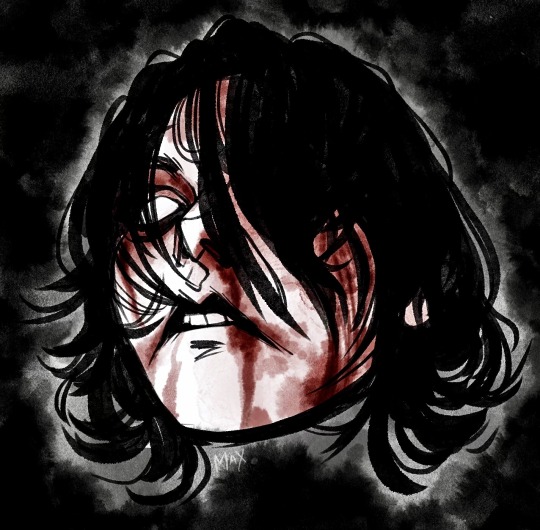
too addicted to that pic of gerard
#and too addicted to that 2000s comic book style#had jhonen vasquez and gerard’s style in mind while drawin this#plus the three cheers album cover of course#anyways this was just a nice change of pace :) a good break from my normal style :)#art#my art 🦷#mcr fanart#mcr#my chemical romance#gerard way#digital art#cw blood#blood#three cheers for sweet revenge
378 notes
·
View notes
Text
Research: Storytelling project
JOCK
Mark Simpson, best known as Jock, is a Scottish comic book artist and illustrator. He began his career in 1999 working on the British comic book publisher 2000 AD (where most of the British artists and writers, began their career, before going to the major leagues like DC and Marvel), and started working with characters like the Judge Dredd.
The artist began his career in the USA with The Losers, at Vertigo (a subdivision of DC comics), and some issues of the Green Arrow.
He also have worked with conceptual arts for various films such as Iron man 3, X-men days of the future past, and Star Wars episode VIII.
I have known Jock for a while, I have seen many of his works in the comics, and he is known for working mainly with covers, where he does extremely surreal works, mixing various types of colors, and always uses a lot of shading, not worrying if the characters are in the correct proportion, because that is not his proposal.
But I know he did some works as a sequential artist, like The Losers, for example, where he makes extremely tight pictures, always focusing on the expressions of the characters, and especially on the hands that he most likes to do.
His storyboards or sketches are very different, because his drawings do not follow the traditional way of being centered on the pictures, many of his characters are jumping over the pictures, to show the size of the action scene that Jock wants to do.
It is worth remembering that he mixes his drawings made with pencil and nanquin, with digital, often taking pictures of different landscapes or scenarios, and drawing over them, and mixing with his drawn character to make an interesting composition.
Despite all this, he has a very peculiar style, which many people complain about the lack of movement and poses that his characters does. That his lines are also very dirty and dark. But Jock says, that this is his way of drawing, that he likes to have a not so commercial style, like many other artists. He likes to play with colors and likes to draw his characters, in a little more simple poses, and glorifying the background.
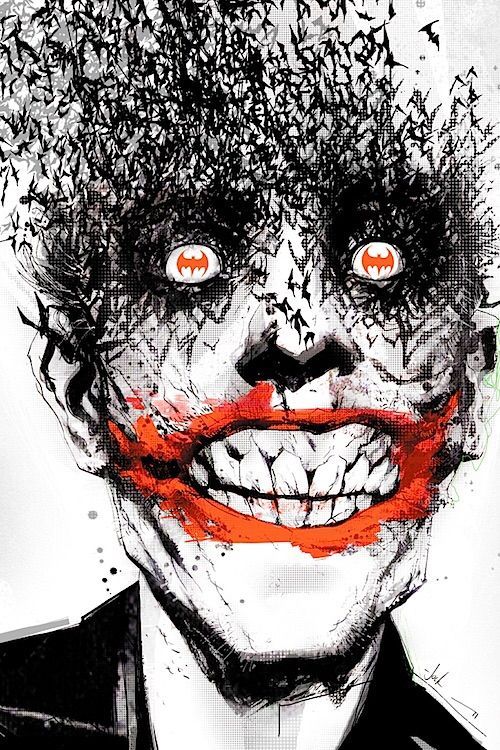


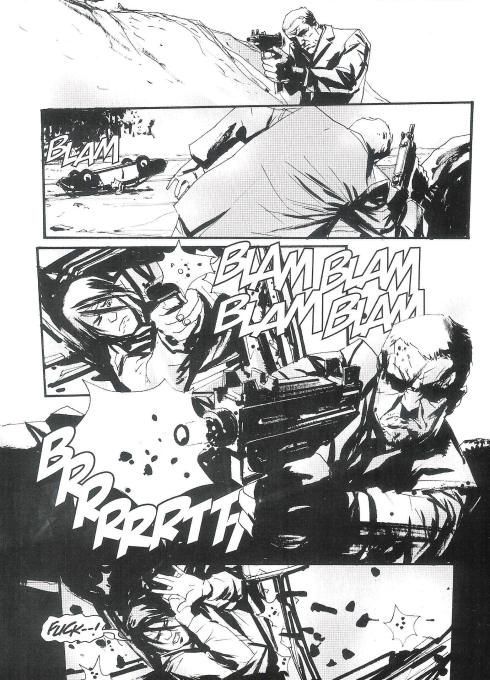
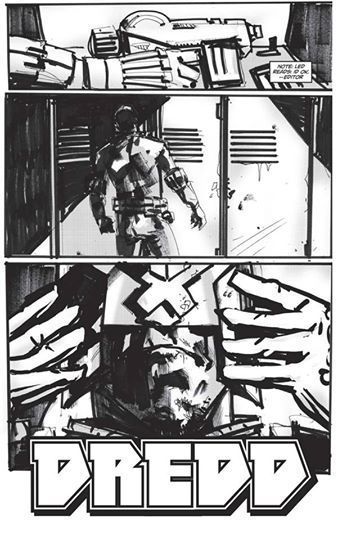
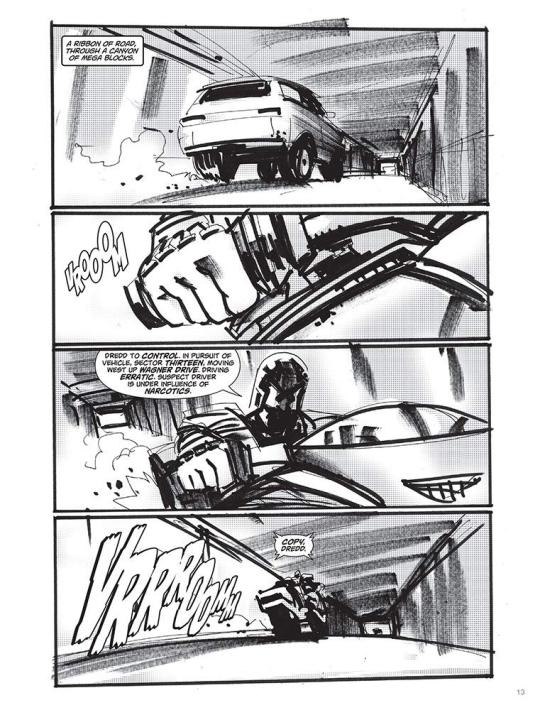
Saul Bass
Saul Bass was an American graphic designer and filmmaker, he’s known for designing movie posters and title sequences.
For 40th years, he worked with Hollywood greatest filmmakers, such as Stanley Kubrick, Alfred Hitchcock, Martin Scorsese and Billy Wilder.
Bass was born in New York in 1920, to a Jewish family, he was all ways drawing when he was a child.He graduated from James Monroe High school in the Bronx. He studied part time at art students league in Manhattan, and moved to Brooklyn College, where he had classes with György Kepes, a famous Hungarian painter and photographer.
He began in Hollywood in the 40’s, designing prints for films like champion (1949), death salesman (1951) and the moon is blue (1953).
He became widely known for creating the title sequence for Otto Preminger’s The man with the golden arm (1955), which’s about a jazz musician, addicted to heroin. Bass decided to create a poster which dialogues with the controversial subject, so he chosed the arm as the central object, as is a image which relates with heroin.
For Alfred Hitchcock, he provided memorable posters, like Vertigo(1958), North by Northwest(1959) and Psycho(1960).
For Martin Scorsese he had done the posters of The Goodfellas(1990), Cape Fear (1991), the Age of innocence (1993) and Casino (1995).
For Stanley Kubrick, he designed Spartacus (1960), and probably the best poster in his career, which is the poster from The Shining (1980).Kubrick, however, wasn’t amused. On the sketches themselves (which were later discovered in his personal affects) he wrote “Looks like science fiction.”Title looks small, looks like the ink didn’t take on the part that goes light,” and “Maze too abstract and too much emphasis on maze,” and, the most scathing of all, “Don’t like artwork.”
More discussions followed, and Bass agreed upon an illustrative approach of a large head peering through the title.As Kubrick instructed, the poster evokes both “terror” and the “supernatural.”
Bass once told,that his main goal for his titles sequences is “try to reach for a simple, visual phrase that tells you what the picture is all about and evokes the essence of the story".




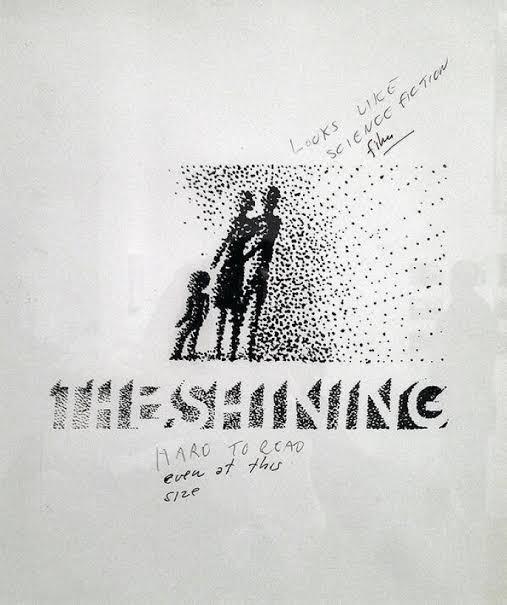
James Cameron
James Cameron is a famous film director, which is for having two of the greatest box office films of all time, which are Avatar and Titanic. In addition, he is always revolutionizing in special effects, always bringing something new and revolutionary, but it all starts on his drawing desk, with his sketches and storyboards.
James Cameron has always been known for creating extremely interesting worlds, and completely out of the ordinary. Starting with the film Aliens, the sequel to Ridely Scott's film, where he expanded this world by creating an ecosystem for the aliens, in addition to showing futuristic equipment, for the space army that faces the aliens.
He also created concepts, for the Terminator films 1 and 2, where it was an idea never before seen of a robot that travels in time to kill a person. Its detailed perfectly drawn storyboards show one of the most interesting scenes in the film, where the terminator does a self surgery, revealing his true form.
And finally, once again creating a whole world, with a fauna and flora never seen before in the movie Avatar.
Cameron always wanted to create worlds, so he putted everything on a piece of paper when he was a child, where later, he took courses of drawings and did art colleges, to get a clearer idea of how his worlds and characters could be.
Before being a director, he wanted to be a writer and an artist, but he never thought his ideals could be just in a book, he wanted to expand these ideas in a way never seen before.
Perhaps what impresses me most about James Cameron, besides being a creative force, is all the care he takes with his works, he said in an interview, which he always preserves all his storyboards, even from those films that he never made or did not work, and said that almost every day, he sits at his drawing desk and tries to come up with possible scenes for any film he is making. And when he creates an interesting scene, he tries to invent a whole story, to get to that specific scene.
https://issuu.com/dteditore/docs/spidercameron-screen-eng/1?ff
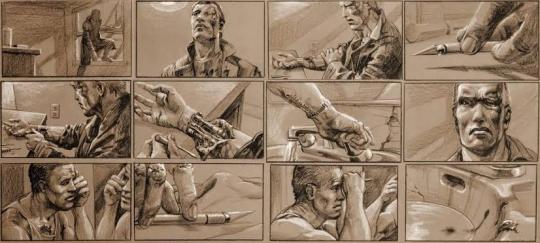

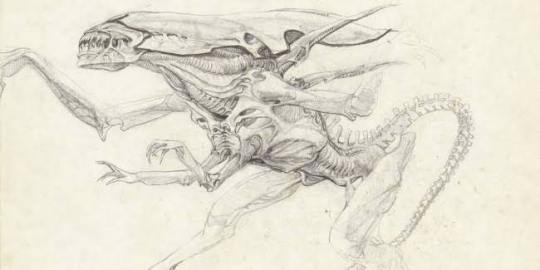
Glen Keane
Glen Keane was born on April 23, 1954, in the city of Philadelphia, United States. Early on, he became interested in art while watching his cartoonist father Bill Keane draw. After finishing high school, he turned down a scholarship to play football and signed up for CalArts- California Institute of Arts.
Keane signed up for the painting program, he wanted to be a visual artist. However, his application was accidentally sent to the animation department, then Film Graphics. The college vetoed him to change course, so he stayed there.
Glen’s passion for painting helped him tremendously in animation, since the first skill an animator must have is knowing how to draw. Do not simply draw, but really know anatomy and how to give the illusion of weight.
His first work was Bernardo and Bianca in the kangaroo land. In the following years Keane worked on other features such as the Hound and the fox, Oliver and his gang , treasure planet, and the list goes on.
But it’s was at the time called the Disney Renaissance that Keane stood out. He animated Ariel the little mermaid, Beast from the beauty and the beast, Aladdin, Pocahontas, Tarzan, and most recently, was Rapunzel (Tangled).
At the time, Keane and the animators, had to use the traditional animation (by using paper), so him and his crew had to plan, all the scenes and poses, by doing storyboards, and later drawing on the paper frame by frame (the frequency to project a film in the cinema is twenty four frames per second, twenty four drawings in total were needed for each second of animation seen on screen).
There is no professional on the animation field, who does not know the name Glen Keane. He is the reference to all of them. What sets him apart, is his passion for his characters. During the production of the animations, Keane understands them and is thus able to perform better.
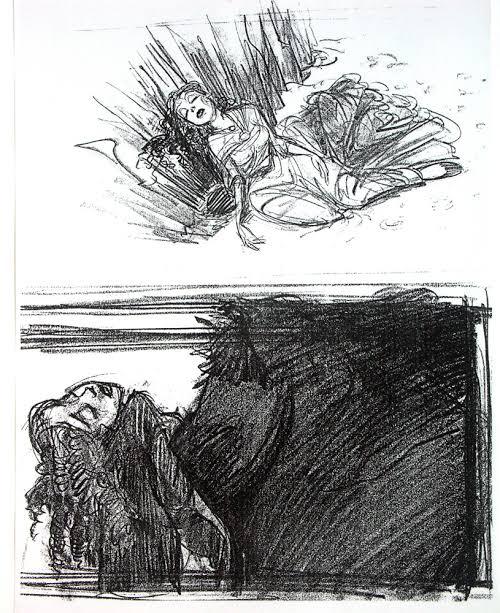
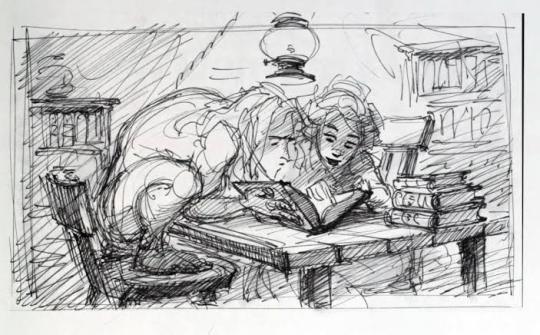

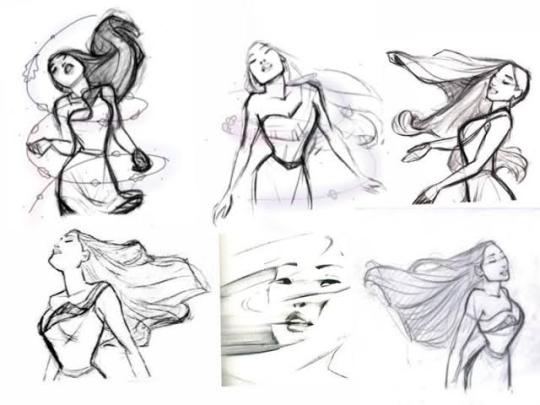

4 notes
·
View notes
Photo


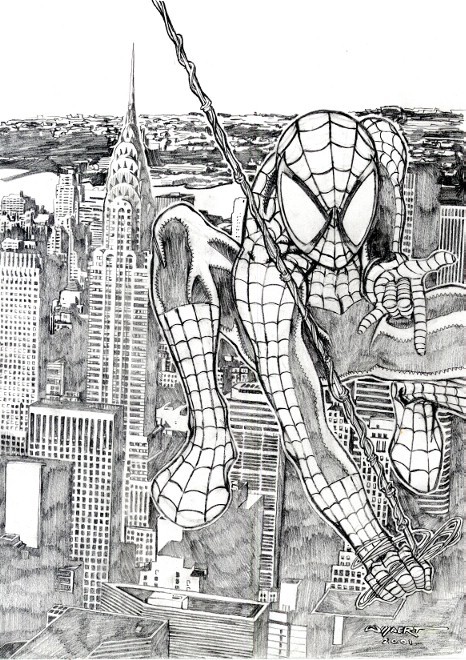
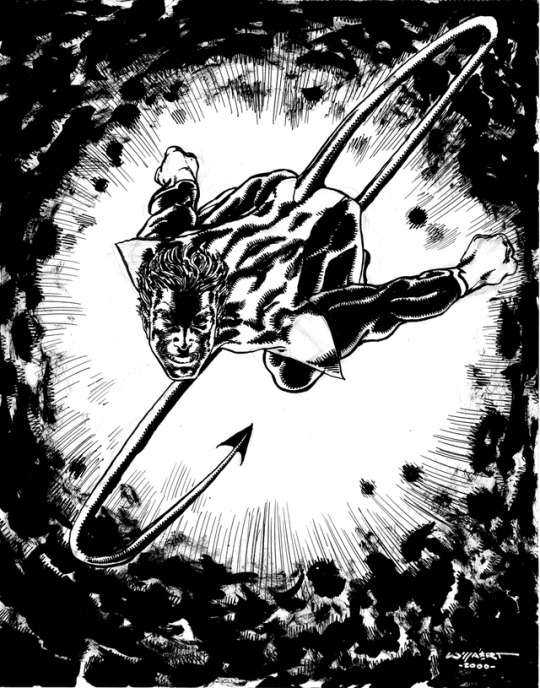

My Secret Origin (Part 1): How To Fail At Comics
[Above: Art from 20 years ago, when I was in High School.]
What do you want to be when you grow up?
When I was four I said “mad scientist.” It was 1987 and I was a big fan of The Real Ghostbusters and Doc Brown. My mom insisted “mad scientist” wasn’t a profession. And weren’t those characters are inventors? What did I want to invent?
Clearly I hadn’t thought this through.
My mom also informed me that all those cartoons I watch were made by people. Those were drawings, and there are people whose job it was to draw those.
This blew my mind. From that point on I decided I was going to be an animator.
Discovering Art
I don’t remember when I first started drawing. It seems like something I always did growing up. As far as my memory is concerned, I came out of the womb holding a pencil and began drawing before I said my first words.
In reality, I probably started in preschool when I was four, just before I discovered what an animator was. I remember my favorite subject to draw was the Ecto-1 from Ghostbusters. I must’ve drawn it something like 10 or 20 times.
My mom kept almost all of my childhood art, so in theory I could figure out when I started drawing from that...except the earliest drawings were ruined when the basement flooded.
After the flooding, my mom was condensing what was left, and I saw something surprising: a box filled with Ecto-1 drawings. I hadn’t drawn it 10 or 20 times, I’d drawn it 100 or 200 times. Repetitively, over and over, without consciously thinking about what I was doing.
It was practice without realizing I was practicing. I guess that’s how my art “leveled up” so quickly?
Later I discovered other details about my early development. There was a time around age 2 where I stopped talking. There were times when I liked to line up toys. My obsession before art was Legos, building complex shapes and stairs.
Today these might be recognized as possible indicators of autism, but this was the ‘80s.
Because I was shy and lacking in social skills, a teacher suggested to my parents that I might benefit from being held back a grade. I had a summer birthday, so holding me back would make me one of the oldest rather than the youngest.
Thankfully my parents didn’t take that advice. I would’ve been miserable. Despite being the youngest in my class, I surpassed everyone in terms of scores. A CAT test says I scored “higher than 99% of all 3rd grade student in the nation in total language.” 91% in reading. 90% in math. My reading comprehension was 98% in the nation, but was brought down by my reading vocabulary which was only 72%.
Yet this new information called into question a things about myself I’d never considered. Maybe certain things suddenly made more sense? In particular, the way I don’t have interests so much as obsessions. Any time I take an interest in a topic, it leads to an obsessive amount of research.
Discovering Comics
I think the first comic I ever saw was a Chick Tract some kid showed me in Sunday School. He was surprised I’d never seen one. It must’ve hadan impact on me, because I attempted to draw a tract-style comic starring C.O.P.S. (“Fighting Crime In A Future Time”).
I didn’t discover REAL comic books until a few years later. In 1991, Terminator 2: Judgement Day marketing was in full force and I thought it looked so cool. But it was Rated R, and I was only seven. My mom spotted a couple issues of a Marvel comic adaptation (drawn by Klaus Janson), and I guess that was the compromise until it was out on video.
I attempted to illustrate a comic imitating Janson’s cram-packed panel-per-page ratio. It was an epic crossover where Michael Keaton Batman encounters a Delorean driven by a T-1000, then the Ninja Turtles show up, and maybe the Ghostbusters? I knew how to introduce characters but not how to finish a story.
At this point I was still imagining becoming an animator, even though I barely knew anything about what it involved beyond some flip books I’d done. But all that changed when I discovered the X-Men.
X-Men and Batman: The Animated Series both debuted on FOX during the fall of 1992. I was a huge fan of the Tim Burton Batman movies and I’d seen every episode of the ‘60s show when it was revived in reruns, but I didn’t know the comics existed? I didn’t even know where to find comics.
My brother and I were both really into this new X-Men thing, and my brother was given a set of X-Men comics for his birthday. I borrowed them of course, and wanted to see how the story continued. My mom showed us a book store in the mall that had comics, and then we discovered the local comic store. That started my monthly addiction.
Now age 10, I decided I no longer wanted to be an animator. Comics were my true calling. And my dream was to break in at age 16.
Learning Comics
Age 11: I went from reading just Uncanny X-Men to buying the entire X-line, thanks to and event called Age Of Apocalypse.
Age 12: I started buying Wizard magazine. The first two issues I bought included life-changing information, like that you get hired by building a portfolio and showing it to editors. There was industry news, and art tutorials by Greg Capullo. I added the magazine to my monthly buy list. An X-Men 30th anniversary special gave me the entire history of the characters, and a run-down of the key artists and writers with examples of their work. It was like a Rosetta Stone before Wikipedia.
Age 13: I started buying most of Marvel’s output thanks to an event called Heroes Reborn. I never got into the Batbooks, I guess because the art didn’t look as cool? Comics contained ads for the Joe Kubert School, which became my backup plan if I didn’t break into comics on my own. I also discovered the internet around this time.
Age 14: My first year of high school. I spent every lunch hour in the library browsing the internet, since we didn’t have a computer at home yet. I discovered several comic art forums where pros and amateurs traded tips. During the summer I attended a week long art session taught at a local college by a professor who grew up on ‘60s Marvel. There I learned I’d been using paper that was much too thin to ink on, and I learned about the importance of Jack Kirby.
Age 15: I started buying Comic Book Artist magazine. I thought it’d be about drawing tips, but instead it was filled with fascinating comics history, which became an obsession of its own.
Age 16: A year of disappointment. I knew I wasn’t at the level I needed to be to get pro work, but wasn’t sure how to get to the next level. Nowadays there are all sorts of resources I could’ve used, but back then there was no Youtube, no social media, and few books about the craft of comics.
I was now certain the Joe Kubert School was the way to go.
Changing Plans
My family took a trip to Dover, NJ to visit the Joe Kubert School campus, and it was pretty disappointing. The town didn’t feel super friendly, and the school wasn’t accredited, which raised issues in regards to getting student aid. Plus the idea of spending so much money on a non-degree.
The guy showing me around tried to sell me by pointing out that comic companies don’t care about whether you went to college, they just want to see the portfolio.
I took this to heart and decided not to go to college. I was pretty crushed at first, because I’d had this dream plan for so long, and now I was plan-less. But eventually a new plan began to form.
It was time to start doing conventions.
A startup called CrossGen had a sample script and were taking submissions at SDCC 2000, so I went there. I still felt like my work wasn’t quite ready for prime time, but i was worth a shot.
And nothing came of it, other than a cool Crossgen rejection letter in a box somewhere. None of the other publishers could be bothered to even send that.
In hindsight, I was trying to enter at maybe the worst possible time in comics history. When I first started reading comics, they were at their peak during a boom period. When the bubble burst, the industry experienced year-over-year plummeting sales with no bottom in sight. No one was hiring.
But I kept at it, hoping for a lucky break. Top Cow was impressed that I did backgrounds (lol), and suggested I send in “background samples,” but I didn’t want to go down that route. But maybe that’s what a lucky break looks like? (On the other hand, many aspiring pencillers who start as inkers or colorists get stuck there.)
The next summer I went to Chicago with a Marvel sample script. I’d just graduated from high school, so I was really hoping. This time I got a critique from an editor who had actual advice to offer, and I learned a few things. But still no one was hiring.
I thought if I just stayed home and worked on art for a year, I’d eventually come up with pages so impressive that they’d HAVE to hire me. And if it didn’t work out after a year, I’d start looking for a college.
But now I was struggling with a new problem. I suddenly hated my art. I’d heard about a few professional artists who didn’t like looking at their own art, but I was certain this was different. After all, they’re actually good.
The year passed and I accomplished nothing. Based on things I’d heard, I was nervous that college might actually price me out of comics entirely. But I didn’t know that for sure, and I was super inexperienced when it came to money, since I’d never lived on my own before.
But I kept hearing how so many people have gone to college and they all turned out okay (this was before social media and before student debt became a crisis). I was clearly having trouble moving forward on my own, and Youtube still didn’t exist, so what choice did I have?
Choosing Schools
There were only a few colleges with comic art programs back then (maybe three total?), but one of them just happened to be over here in Minnesota. Art school appealed to me because all the classes were art-focused, so I wouldn’t have to waste my time with math and other BS.
And as I humble-bragged earlier, I’m good at math. But I hated it. At one point some kids from Math League asked if I’d join the team. “‘MATH LEAGUE?’ You mean you do math for FUN??”
I hated math so much, I took harder, accelerated math courses via a local college, just so I could finish math early and spend my last years of high school wonderfully mathless. If there’d been a similar way to graduate from high school earlier, I would’ve taken it. When I realized we were all graduating regardless of how much work we put in, I stopped caring so much about grades and let an occasional B+ slip in.
When I would see classmates busy studying for their SATs or ACTs, I was so glad I didn’t have to bother with that.
But the joke was on me. Because this art school didn’t just require a portfolio review (which I was more than ready for). It also wanted ACT test results.
I remember wondering if I should study before I take it, since everyone took it so seriously in high school. But I didn’t even know how to study. It’s not a skill I’d learned, because I never needed to. So I decided to wing it.
You’ll hate me, but without studying I scored in the top 96% for English, the top 94% for Reading, the top 96% for Science...but only top 87% for Math, because I hadn’t taken a math class in three years. That brought my total down 90%..
(Later, I had to learn to study in order to pass some horrifically-taught art history classes. That teacher made me hate art history, which is ironic given how much of my own writing is focused on history.)
So I got into the school, only to discover that even structured teaching wasn’t going to solve my new art problem. During my first year I told my mom that I don’t enjoy art anymore, and she thought it might be depression. I mean, that’s plausible, losing interest in your passions?
In hindsight, I now have enough experience with real depression that I can definitively say it wasn’t that. I mean, I was occasionally depressed back then, but hating my art was unrelated. It took me years to figure out the actual problem.
Dunning Kruger
The Dunning-Kruger Effect is named after a study which found that:
1) People who aren’t knowledgeable about a skill tend to think they’re better at it than they are, because they don’t know enough to know what they don’t know.
2) Conversely, people who ARE knowledgeable about a skill tend to think they’re worse at it than they are.
My problem went one level deeper. I’d learned a shit ton about every skill related to comic art, but I hadn’t put in as much time actually practicing. And now practicing was tough, because I was hyper-aware of how bad every line was as I laid it down.
In other words, the exact reverse of when I was four and drew repetitively on auto-pilot. Back then I was oblivious that I was practicing anything at all. Now I had the benefit and detriment of a critical mind.
But this realization came later. At the time I was just miserable and didn’t know what was wrong with me.
Halfway through art school, I realized I’d likely already priced myself out of comics, and I needed a real degree that would function back-up plan. So I switched majors. Instead of a Comics major filling my electives with design classes, I became a Design major filling my electives with comics classes.
In order to change my major, I had to explain it to the head of the school. This was awkward because it partly involved explaining how the comics industry worked, and he didn’t want to believe it. He told me I was being cynical.
I tried doing comic samples one last time after college, for a convention in 2006, but couldn’t even finish a page. Then sometime around 2008, I gave up drawing entirely.
How I got started again is another story.
You can also find me on:
Instagram - https://www.instagram.com/katewillaert/?hl=en
Twitter - https://twitter.com/katewillaert
Art Patreon - https://www.patreon.com/katewillaert
History Patreon - https://www.patreon.com/acriticalhit
11 notes
·
View notes
Text
The Rise and Fall of PlayFirst Inc.

In the early 2000s, quality options for casual games were limited. You basically had Cubis, Bejeweled, Jewel Quest, and a few thousand Mahjong games.
But in 2004...or 2005, depending on which Wikipedia article you’re looking at, a little company known as PlayFirst Inc. published Diner Dash, effectively changing the world of casual gaming as we know it.

The original Diner Dash was actually developed by Gamelab, who before then had only done a lot of online LEGO games from the look of it, but PlayFirst quickly acquired the rights to the game after they realized they had the golden goose sitting right in their lap.

The story of Diner Dash begins with Flo, a young woman who is fed up with corporate bureaucracy and strikes out on her own to run a restaurant. Which ends up as a whole chain of restaurants, each with a different theme. Now, I use the term “story” loosely because all that really pertains to a story here are a couple of comic book-style screens at the beginning and end. It’s all very standard “follow your dreams” stuff, but trust me, it wasn’t as cliché back then as it is today.

What’s really to talk about here, though, is the gameplay. It’s deceptively simple, gets more challenging with each level, and - as any review of the game will tell you - it’s highly addictive. You seat customers, take customers’ orders, bring customers food, customer leaves a nice fat tip, you clean the table. Lather rinse repeat. But! Dining parties get larger and arrive faster as the game progresses, and they also come in more colors, which are matched to seats for bonus points. But you also get perks that help you, such as complimentary drinks and a podium to entertain customers waiting to be seated. All in all, it’s a perfect time waster game. And even if you make it to the end, you still feel compelled to get the expert score on every level. At least...that’s the way I feel.

After Diner Dash cemented itself as a classic, PlayFirst dedicated most of their lifetime to milking this cash cow for all it was worth. The game itself received four official sequels: Restaurant Rescue, in which Flo helps her restaurateur friends revamp their kitchens and pay rent; Flo on the Go, with the added gimmick of getting to change Flo’s clothes after she loses her suitcase on vacation; Hometown Hero, in which Flo visits her Grandma Florence and - what else - helps to revamp the local restaurants to their former glory; and BOOM!, in which Flo’s Diner is flooded with so many customers that it literally explodes and the money you earn goes toward rebuilding it. They also put out some more novelty titles like Seasonal Snack Pack and Flo Through Time, but these seem to be regarded as lesser installments.

(And did I mention the Spongebob version?)
But of course, one can’t mention Diner Dash without mentioning...the spin-offs.
In addition to the proper Diner Dash series, PlayFirst released several other “Dash” games following the same general formula, but set in different businesses with different protagonists.

The most successful of these was Wedding Dash, starring Flo’s friend Quinn who tries to make it as a wedding planner. It was so successful that they actually made three sequels.
Then came Doggie Dash, Dairy Dash, Parking Dash...(that seems like an oxymoron). All of which were fun in their own right, don’t get me wrong, but by no means lived up to the original. And you can tell that not all spin-offs really had the same budget, especially when it came to art and animation.

There was also Cooking Dash (which if you ask me was just Diner Dash trying to be Delicious, but that’s an article for another day), DinerTown Detective Agency which served as the obligatory hidden object game, and DinerTown Tycoon.

Amazingly enough, though, the Dash empire was not PlayFirst’s only claim to fame. They also worked on Chocolatier, a tycoon series in which you travel back in time to run a chocolate company, and the Dream Chronicles series, equal parts hidden object and puzzle that actually had a really good story set in a world of fairies.

PlayFirst also had some great little standalone games. In 2006, they released Plantasia, a crazy time management-slash-puzzle game where you use magic to bring gardens back to life.
They actually made this in collaboration once again with Gamelab who, despite having effectively sold the rights to their own personal gold mine, actually weren’t doing too bad for themselves. They ended up developing the first two Jojo’s Fashion Show games and the highly underrated Miss Management.

Then in 2009, PlayFirst collaborated with Wadjet Eye Games (one of my very favorite game developers) to make Emerald City Confidential, a point & click adventure set forty years after the events of The Wizard of Oz. And while Wadjet Eye’s CEO Dave Gilbert expressed significant creative differences between the two companies (watch his game commentary on YouTube), I still think the final product is amazing.

And in the same year, if you can believe it, PlayFirst took all that Wadjet Eye had taught them and released Avenue Flo, a fully-voiced point & click adventure based on Flo and the other characters of DinerTown, complete with a singalong theme song! And wouldn’t you know it, it even got a sequel.
Unfortunately, the Avenues Flo were pretty much the last good hurrah for PlayFirst. They just kept stretching and stretching and stretching the spin-off thing as far as it could go and the magic just wasn’t there anymore. They weren’t really adding anything of substance to their new games - only making them gimmickier. The reason I loved Avenue Flo so much was because it gave me a slice-of-life view of the characters of DinerTown; actually let me talk to and learn about them, rather than just shuffling them through a diner or a fitness center or a freaking soap opera shoot.

(Don’t get me wrong, Soap Opera Dash is still rad.)

The other thing that really sent PlayFirst on the path downhill was that they became very diligent about porting their games to mobile. At first, these ports were pretty successful. I mean, duh. Why wouldn’t they be. You port Diner Dash to anything, it’s going to be successful.

(Except for...most things Diner Dash was ported to.)
They were so successful, in fact, that in 2012, PlayFirst officially announced that they would cease production of all computer games to focus their efforts on the mobile market. Which means any games in progress were cancelled, which means we never got Dream Chronicles 6, and I’m still bitter about it.
Then...tragedy.
In 2014, PlayFirst Inc. was purchased by Glu Mobile. (You know, the company that makes the Kim Kardashian game? Yeah, those guys.) Most of their titles understandably went on backlog and are now only available through third-party sellers. Which, thank God, there are a lot of.

But Diner Dash, cash cow that it is, kept being developed for the modern audience. Which means the game got way more complicated than it needed to be, with weird power ups, too many new restaurants, and Flo and her friends getting really, really ugly makeovers.

Like, is that supposed to be Grandma Florence?
And that’s about when Gordon Ramsay got involved and the dream well and truly died.
But no matter what the bloodsucking Glu cronies are trying to do to our beloved Flo, PlayFirst will always live on in memory as one of the giants of the casual gaming world.
8 notes
·
View notes
Text
[Editor’s Note: This review may contain spoilers]
Writers: Len Wein, Tom King
Artists: Jason Fabok, Kelly Jones
Summary
In “Talk of The Saints”, Swamp Thing struggles against a brutal, unending snow storm that cuts him off from the green to protect a young child from an unseen “snow monster” in pursuit. The unnamed child claims this snow monster happened upon his family and killed them before Swamp Thing intervened, but the muck-encrusted Avatar doesn’t remember any of that, let alone keeps track of the events of the previous day. Besides the cold, the creature once known as Dr. Alec Holland protects the boy from both a bear and an insane cannibalistic hunter, but no snow monster. Little by little, Swamp Thing starts to wither away, given the constant cold and disconnection from The Green. But what he discovers next will shake him, and the audience, to their cores.
In Len Wein’s plotted story – intended to be the first issue of a miniseries entitled Swamp Thing: The Dead Don’t Sleep – Solomon Grundy steals a baby from Gold Manor outside Gotham City. Marc Cable, in the hospital following his possession by Anton Arcane, informs a visiting Swamp Thing he is sticking around and contemplating a career in private investigation. Back in Gotham, Commissioner Gordon and the GCPD investigate the kidnapping at the manor. Batman consults with Gordon on the matter and swears to get to the bottom of this. Grundy, meanwhile, has taken refuge on a box car train and attacks hobos that happen upon him. The child, Cynthia, dissolves his finger as she grasps it; the appendage reforms upon her release of it. Back in the swamp, Swamp Thing gets into an altercation with fan boat sailors which is ended by the intervention of Batman.
Positives
Both stories in this annual work in terms of creativity and presentation. However, instead of in order, I would like to start with the final story; specifically, Len Wein’s final story. I remember a line of Marvel comic books back in the early 2000’s called the “Nuff Said” line. The concept was only visual storytelling in one month of their titles with no text. This left the reader to their own devices and imagination as to what the dialogue could be. This concept made it possible for this presentation of Len’s plotted first part. According to the editor’s note, Len had sadly passed away before he could provide dialogue, so collaborator Kelley Jones had only the plotted script to work from.
Given his role as regular Swamp Thing artist, Jones’ work doesn’t deviate from the main title in spite of it being a miniseries. The manner in which he conveys both the gargantuan brutes – Swampy and Grundy – shows Kelley to truly be Bernie Wrightston’s successor. With few surface details and distinctive line thickness, you can feel the weight of Swamp Thing’s mass and almost cringe when he snakes out of that potted plant and forms in Matt Cable’s hospital room. He keeps the surface detail to a minimum, but the linework on the neck veins and the basic head design taps into Bernie’s original concept.
Jones was a regular on Batman books back in the nineties, first as cover artist – he got the distinct honor of drawing the cover featuring that infamous back breaker from Bane during the Knightfall storyline – and interior artist later on. His style and composition evokes the right balance of noir and horror that made Swamp Thing the hit that it was at its outset and through the Alan Moore years. Without color, it would not lose its hold over the audience and yet become a brilliant demonstration in negative space. Any art student wishing to break into comics should take a look at these pages; this is the true test of any penciller specializing in sequential storytelling. The art has to tell the tales as much as the dialogue, and Jones does that beautifully. And he has not lost his touch on drawing Batman.
As to the main story, “Talk of the Saints,” Fabok and King craft a unique tale which feels very stand alone, also in the spirit of Alan Moore. There are no thought balloons, no real way to determine how long it’s been, save for the repetitive word “Later” in captions. Fabok’s design of Swamp Thing succeeds in incredible surface detail. The fact that he is also the cover artist and delivers a truly haunting image of Swamp Thing and the child draws you immediately in. You can almost feel every root or twig sticking out of him. King’s interesting demos of his abilities – tearing off his own hand to provide material for a fire, or growing edible berries from his forefinger – shows just how disconnected Swamp Thing is from his own humanity. There’s not one scream of pain or visible agony save for the starvation of his very environment.
Further, Tom shows how stoic the creature is to kill a bear and a trigger-happy hunter with the same speech. Not one sign of anger or outrage on the character, nor one exclamation mark or bold lettering in the dialogue balloons; it’s Tom’s desire to show nature at its most merciless by showing how emotionless and resolved Swamp Thing can be. Tom gave the Dark Knight a similar repetitive sentence directed towards his Venom-addicted nemesis in the “I Am Bane” plot in Batman. As to the snow monster that never comes, Tom builds your anticipation through the boy’s accounts of unforeseen, previous events, but then at the midway point you start to question the boy’s honesty as Swamp Thing simultaneously does.
Fabok’s decision to make the revelation a splash page reveal is powerful in its simplicity. Both figures are set against a snowy, barren wasteland with nothing deviating the reader’s eyes from the central focus on Swamp Thing, the boy, and Holland’s orange dialogue balloons. The shock value is not lost on the reader, nor is the final solution. The tears Jason draws in Swamp Thing’s eyes returns that notion of humanity to this withered plant man. For what is claimed as years, he’s tried to save the boy only to discover he’s been had, and must make a very difficult decision. Further, he feels that by sacrificing the boy he cuts away another part of him that was human. Anyone can identify with that inner conflict. That idea of us believing one person’s story, only for it to be revealed as a deception and the need to break away in spite of a part of us that wants to believe in that person. What makes this work is the boy is still crying and still insists Swamp Thing saves him; whether he knew what he truly was or was just as deceived as Alec Holland remains up to the reader. Brilliant writing and fantastic visuals overall.
Negatives
The only drawback to Kelley’s work on Len’s final story is all of the above details were only possible through the accompanying outline of the plot. You’re trying to make sense of what is happening or who Grundy is attacking without the benefit of captions or signs. There are times when your eyes are wandering to find some sense of direction and identification of some of the players. If you’re new to Swamp Thing, you only notice him first and not any of the other human characters, save for staples like Batman and Gordon. Also, James Gordon is depicted as a younger man in the comics these days, so the white mustache is out of place.
Speaking of displacement, if this is the Rebirth era, why does Jones draw Batman in his New 52 uniform? You can tell by the kneepads and the lines connected to the chest emblem in that final shot. Did Len intend on making it a tale told in the past? As to the longer story, there’s very little I can say that’s bad about it. It’s a true testament to the spirit of Swamp Thing and Len Wein’s legacy. The only complaints I have begin with the fact that we never find out exactly what that boy was, or why the radio broadcasts were relevant bookends to this story. Also, you can’t exactly tell how many years Swamp Thing was in that snowy wilderness, or how far the weather extended. It shares the same flaw as the second story in that it feels very time displaced.
Verdict
In spite of some notable flaws, both stories bring out the best in the character and honor the legacy left by one of comics’ most brilliant writers gone too soon. I sincerely would’ve loved to have read that miniseries. Thank you, Len, for Swamp Thing, for Wolverine, for your run on The Incredible Hulk, Fantastic Four, and every relevant title for both Marvel and for DC. You will not be forgotten and can never be replaced. Your legacy, and especially a certain muck-encrusted mockery of a man, is left in capable hands.
Review: Swamp Thing Winter Special #1 Writers: Len Wein, Tom King Artists: Jason Fabok, Kelly Jones Summary In “Talk of The Saints”, Swamp Thing struggles against a brutal, unending snow storm that cuts him off from the green to protect a young child from an unseen “snow monster” in pursuit.
6 notes
·
View notes
Photo

Hello friends! For the past three years I’ve been bringing you spooky and creepy cute magical girls to watch for the season.
The list is dwindling after the last two years but I have some more.
This year is gonna focus less on cutesy witches and more on horror (gore, psychological horror, etc.). As always I’m sticking to mostly animated series (last year’s had webcomics)
You can see my other list here:
Halloween Magical Girl Recommendations (2)
Black & Brown Magical Girls
Western Magical Girl List
Anime Magical Girl Recommendations
Magical Girl Indie Comics
LGBTQ+ & Gender Non-Conforming Magical Girls
Disabled Magical Girls
So onto the list:

Magical Girl Raising Project (2016 Series)
After Lyrical Nanoha and Madoka Magica sky rocketed dark edgy “maguca is suffering” type of magical girls into the limelight everyone’s clamoring to be the next Madoka. Many fall short (Day Break Illusion). While others I wind up enjoying a lot more - Magical Girl Raising Project. They’re upfront with the show is about- they straight up tell you in the synops that this is a magical girl battle royal situation. Magical Girls will die and they will die at the hand of other Magical Girls. This being said they still manage to make you feel for the characters- I knew people were going to die and I still got attached to them. They also manage to throw in a couple twist and surprises despite everyone already knowing the DARK thing. Also CANONICAL LESBIANS (everyone dies tho so). I really liked this show. This is the closest thing I’ve watched to a Magical Girl Thriller and it’s highly addicting!
Also, my friends and I are running a fan book dedicated to Magical Girl Raising Project, you can find out more information at @mgrpfanbook

Ayashi no Ceres (2000)
You familiar with the stories of Selkies? Swan Maidens? Some mortals steal the cloak (representing the maiden’s purity) of a beautiful but super natural creature to keep them captive with them? Ayashi no Ceres is basically that but with a lot more murder. This toes the line of what a magical girl is but I include it because it technically ticks all my boxes.
Ceres was one of the series features in the Lesser Known Magical Girls Zine - you can find more information at @pro-magical-girl-enthusiast

Shamanic Princess (1996 Series)
Shamanic Princess is hailed as the first dark magical girl series. This 6 episode OVA again pushes what it is to be a magical girl but definitely fits within the realm of the genre unlike Ceres which toes the line. Tiara has to rescue a valuable and dangerous artifact in the magical world from our world. But her best friend is trying to stop her kinda? It’s free on Funamation’s Stream I think and I highly recommend it. Body horror galore is perfect for Halloween.
Shamanic Princess was one of the series features in the Lesser Known Magical Girls Zine - you can find more information at @pro-magical-girl-enthusiast
Here’s a couple of shows to cheer you up after all of that!

Little Witch Academia (2017 Series)
I recommended the two movies on my original list! Now the series it out and I’m recommending that too! It’s on Netflix and Crunchyroll. Give it a watch and it’ll put a smile on your face after all the stuff above.

Is this a Zombie? (2011 Series, there is a sequel)
Magical Girl Parody featuring zombies, necromancers and a She-Zow style situation of a boy becoming a magical girl. Pls be warned - here there be fan service.
And that’s all I got until next year friends! Stay spooky~!
75 notes
·
View notes
Link
Note: today's review is a sequel, and though I do my best to avoid spoilers for the entire series, if you're afraid of having elements spoiled, you may want to wait to read this review!
Today's review is part of the blog tour for Spill Zone: The Broken Vow, the second in a duology helmed by YA powerhouse Scott Westerfeld! To see what other readers thought, make sure to check out the rest of the stops on the blog tour! Full list at the end of this post! =)
Spill Zone: The Broken Vow by Scott Westerfeld
Art by Alex Puvilland
Graphic novel / science fiction, 240 pages
Published July 10th 2018 by First Second
All hell breaks loose in the second volume of New York Times–bestselling author Scott Westerfeld's visionary graphic novel duology.
Three years ago an event destroyed the small city of Poughkeepsie, forever changing reality within its borders. Strange manifestations and lethal dangers now await anyone who enters the Spill Zone. Addison got close enough to the Spill Zone to touch it, literally. She survived the encounter, but came back changed.
It turns out she's not alone. North Korea has its own Spill Zone, and a young man named Don Jae is the only one who made it out alive. Alive, but changed. Now Addison, Don Jae, and, curiously, a rag doll named Vespertine, share an unholy bond and uncanny powers.
From Scott Westerfeld, the inspired imagination behind the New York Times bestsellers Uglies and Leviathan, comes The Broken Vow, the second volume of our highly anticipated new graphic novel series.
The Broken Vow is the follow-up and conclusion to 2017’s Spill Zone [REVIEW], a trippy little sci-fi-ish story of a girl doing what she has to to survive and care for her little sister, Lexa, in the wake of a catastrophe that wiped out her city (sort of) in some rather inexplicable ways. The beauty of Spill Zone was in the discovery — in seeing how Addison’s world has changed; in the little discoveries of this weird remainder of a city, that only she sees; in the general world-building and stakes-setting of Addison’s life and what it means to do what she does. This tends to be true of firsts in a series, and is maybe part of why seconds aren’t normally as successful or satisfying as that initial exposure to the world; the exciting discovery phase is over, and now you have to go about the business of setting things to rights, and that’s just never as fun.
In some ways, I think this is true of The Broken Vow. Most of the world-building is over, and though there are still some discoveries to make, the shine of a new world has begun to wear off. I still tore through this volume, and still enjoyed it, but where I feel like Spill Zone stuck with me for quite some time after reading, and I was eager to get back to the world with book 2, The Broken Vow has faded from memory so fast that I was struggling to remember what had happened when I sat down to write this review, even though I only just read it a short couple of weeks ago.
New cover style for the book 1 rerelease!
This is not to say that it’s a fail. I still enjoyed the story, and getting back to this world. I find Addison an intriguing, strong character, and I enjoy the relationships and dynamics that have been built. But something about The Broken Vow feels a bit off, and a bit rushed – and maybe it was? I was hoping it'd be a longer series, with a slower reveal, and part of me wonders if maybe it was intended to be. There were a lot of things I liked, like the slow reveal of Addy’s little sister's role in everything, and the development of the relationship between her and Verspertine, her creepy af talking doll, or the further reveal of the role the Korean spill survivor, Don Jae, has to play, and how he expands the world for Addison. But in some ways these things only emphasized that there was something missing from this book. Don Jae is a good example of this, actually, as I did feel he fell by the wayside, and didn't play as important a part as I would have expected from book one. Again, this goes back to it feeling like it was being wrapped up too quickly -- I almost had the impression that there was more intended for his character, but the series was curtailed and they had to just tie up strings. That feeling was a bit of a bummer. It also spilled over into the resolution of where the beings came from, how the spill happened, etc -- that could have been delved into SO MUCH, could have been stretched over a longer series in a slower, anticipation and tension -building reveal, and maybe even had some scenes from before, flashback-style, but there just… wasn’t much of anything. It was just a quick reveal, this is what it is, this is what happened and why, and okay, now I guess everything’s fine? Even though I liked the story and the whys of it all, it feels like a lot of promise unfulfilled.
I said in the review for book one that the art is not for everybody, which is certainly true, but it is exceptionally well-suited to the story. The chaotic nature and hyper-color of it really adds to the story, giving an excellent example of how art and story go hand in hand in a comic -- the story would have worked fine with different art, sure, but this art (which probably wouldn't have worked for just any story) adds another layer of its own, making the world more fully-realized and distinct. The whole thing is a bit more on the older-YA, adult side as well, so bear that in mind when buying or recommending for younger kids. The bright colors may fool you, but the suspended reanimated bodies and abundance of ..."colorful language" mean that it's definitely not ideal for you seven year old, ya know?
So, I know I've given some serious criticisms here, and I stand by them, but I have to be clear: I still really enjoyed The Broken Vow, and the Spill Zone duology as a whole. And who knows, my opinions may get a little rosier in hindsight, after I've had time to sit with the story for a bit; I was less than glowing in my review of book 1, too, even though I later considered it one of the graphic novel highlights of last year. As a whole, the duology has a world that stuck with me, and characters I found interesting, and it's not really like other things out there, especially in the sort of neon acid-trip art. Like a stern parent, the reason I'm hard on it is because I liked it.
Tough love, darlings.
Curious what other readers thought? Check out the rest of the stops on the Spill Zone: The Broken Vow blog tour! Or pick up a copy of The Broken Vow, which landed in stores yesterday!
7/8 Novel Novice http://www.novelnovice.com/
7/8 Undeniably Book Nerdy http://booksandmakeup.blogspot.com/
7/9 Bookcrushin http://bookcrush.in/
7/9 Hit or Miss Books https://hitormissbooks.wordpress.com/
7/9 Bookling Critics https://booklingcritics.wordpress.com
7/10 Seeing Double in Neverland http://seeingdoubleinneverland.blogspot.com
7/10 WhoRuBlog http://www.whorublog.com
7/11 Here's to Happy Endings http://www.herestohappyendings.com/
7/11 The Book Rat www.thebookrat.com &mdash YOU ARE HERE!
7/12 Miss Print http://missprint.wordpress.com/
7/12 Bookstore Finds Www.instagram.com/bookstorefinds
7/13 Teen Lit Rocks teenlitrocks.com
7/13 Adventures of a Book Junkie https://www.toofondofbooks.com/
7/14 Novel Reality http://novelreality.blogspot.com
7/14 Flavia the Bibliophile http://flaviathebibliophile.com/
7/15 Haku & Books https://www.hakuandbooks.com/
7/15 Emily Reads Everything www.emilyreadseverything.com
7/16 YA Book Nerd http://yabooknerd.blogspot.com/
7/17 Take Me Away to a Great Read https://takemeawaytoagreatread.com/
7/18 Bumbles and Fairy-Tales http://bumblesandfairytales.blogspot.com
7/18 Pink Polka Dot Books http://www.pinkpolkadotbooks.com/
7/19 Folded Pages Distillery www.foldedpagesdistillery.com
7/20 Book Nut Booklovingnut.com
7/21 The Life of a Booknerd Addict http://www.booknerdaddict.com/
About the Author:
Scott Westerfeld is a New York Times bestselling author of YA. He was born in the Texas and now lives in Sydney and New York City. In 2001, Westerfeld married fellow author Justine Larbalestier.
He is best know for the Uglies and Leviathan series, and his next book, Afterworlds, comes out September 23, 2014.
His book Evolution's Darling was a New York Times Notable Book, and won a Special Citation for the 2000 Philip K. Dick Award. So Yesterday won a Victorian Premier's Award and both Leviathan and Midnighters 1: The Secret Hour won Aurealis Awards. Peeps and Uglies were both named as Best Books for Young Adults 2006 by the American Library Association.
Disclosure: The book was sent to me by the publisher for review consideration purposes; all thoughts and opinions are honest and my own.
Affiliate links are used in this post -- thanks for helping supporting this blog! via The Book Rat
0 notes
Text
Gillian Jacobs Height Weight Measurements
New Post has been published on http://hollywoodages.com/gillian-jacobs-height-weight-measurements/
Gillian Jacobs Height Weight Measurements
Gillian Jacobs Biography
Gillian MacLaren Jacobs born October 19, 1982 is an American performing artist. She is known for depicting Britta Perry on the NBC/Yahoo! Screen comic drama arrangement Community and Mickey Dobbs on the Netflix arrangement Love. Jacobs had a repeating part as Mimi-Rose Howard on the fourth period of the HBO arrangement Girls and has showed up in movies, for example, Gardens of the Night (2008), The Lookalike (2014), Life Partners (2014), Hot Tub Time Machine 2 (2015), Don’t Think Twice (2016) and Brother Nature (2016). Jacobs was conceived in Pittsburgh, Pennsylvania. Her folks, Martina Magenau Jacobs and William F. Jacobs Jr., work separately in graduated class relations at Carnegie Mellon University and as a speculation broker. She was brought up in Mt. Lebanon, Pennsylvania. Jacobs was raised by her mom. Her family possessed the Erie Brewing Company in Erie, Pennsylvania, where her granddad, John Martin Magenau Jr., filled in as President and CEO until the point when it shut in 1978. Jacobs started contemplating acting at eight years old, and went to acting classes on Saturdays at the Pittsburgh Playhouse while growing up. She performed with the Pittsburgh Public Theater, where she was an enduring contender in the Public’s Shakespeare Monolog Contest, driving her to be given a role as Titania in its generation of A Midsummer Night’s Dream. Subsequent to moving on from Mt. Lebanon High School in 2000, Jacobs moved to New York City to go to the Juilliard School, where she graduated with a Bachelor of Fine Arts in 2004. Jacobs is a nondrinker. She says she settled on a decision while youthful to never have a mixed drink or take drugs. She says her dad is a someone who is addicted, and together with the wake up call in the youthful grown-up novel Go Ask Alice, around a 15-year-old medication fiend, she ended up frightful of destroying her life a similar way. See Gillian Jacobs Height Weight & Family Info.
Gillian Jacobs Personal Info.
Full Name:
Gillian MacLaren Jacobs
Nick Name:
Gill
Family:
William F. Jacobs Jr. (Father)
Martina Magenau Jacobs (Mother)
William Francis Jacobs (Paternal Grandfather)
Mary Margaret Haskins (Paternal Grandmother)
John Martin Magenau (Maternal Grandfather)
Carol Marie Spiller (Maternal Grandmother)
Samuel Skinner (Uncle)
Education:
Gillian Jacobs went to the Mt. Lebanon High School and graduated in 2000. She at that point moved her base to New York City and got selected at the renowned Juilliard School. She moved on from Juilliard in 2004 with a Bachelor of Fine Arts. While growing up, she used to take acting classes at the Pittsburgh Playhouse on Saturdays.
Date of Birth:
20th October, 1982
Birthplace:
Pittsburgh, Pennsylvania, USA
Zodiac Sign:
Libra
Religion:
Her religious views aren’t known publicly.
Ethnicity:
White
Nationality:
American
Profession:
Actress
Measurements:
34-24-35 in or 86-61-89 cm
Bra Size:
32B
Height:
5′ 4″ (163 cm)
Weight:
104lbs (47 kg)
Eye Color:
Blue
Hair Color:
Blonde
Dress Size:
4
Shoe Size:
7
Boyfriend/Dating History:
Gillian Jacobs has uncovered in interviews that she is in a long haul relationship. In any case, she didn’t reveal his character and only said that he wasn’t from the big time. She is exceptionally defensive of her own life so infrequently uncovers anything about it. Her open appearances with her beau are uncommon too. Here is one after a show in Los Angeles in December 2015.
Known For:
Britta Perry on Community
Active Year:
2005 (present)
Favorite Movies:
American Movie, Fanny & Alexander, The Philadelphia Story, The Raid, A Fish Called Wanda
Favorite Face Wash:
Dr. Lancer’s face scrub and Le Mieux face wash
Favorite Color:
Red
Favorite Emoji:
Kissy Face Emoji
Favorite Book:
Austerlitz by W. G. Sebald
Favorite TV Show:
Getting On (2013-2015)
(adsbygoogle = window.adsbygoogle || []).push();
Favorite Season:
Spring in New York City
Favorite Personal Lady Hero:
Ruth Bader Ginsburg
Favorite Writers:
Roald Dahl, Italo Calvino, Vladimir Nabokov
Favorite Fictional Character:
Ignatius Reilly
Favorite Book She Secretly Loves:
It Seemed Important at the Time by Gloria Vanderbilt
Official Twitter
Twitter
Official Instagram:
Instagram
Film
Year Title 2005 Building Girl 2007 Blackbird 2008 Choke 2008 Gardens of the Night 2009 The Box 2009 Solitary Man 2010 Helena from the Wedding 2010 Nonames 2010 Coach 2011 Let Go 2012 Watching TV with the Red Chinese 2012 Revenge for Jolly! 2012 Adventures in the Sin Bin 2012 Seeking a Friend for the End of the World 2013 The Incredible Burt Wonderstone 2013 It’s Not You, It’s Me 2013 Bad Milo! 2013 The Big Ask 2013 Made in Cleveland 2013 Crush 2014 Life Partners 2014 Walk of Shame 2014 The Lookalike 2014 Black or White 2015 The Queen of Code 2015 Hot Tub Time Machine 2 2015 No Way Jose 2015 Visions 2016 Don’t Think Twice 2016 Dean 2016 Brother Nature 2017 Lemon 2018 Magic Camp 2018 Life of the Party
Television
Year Title 2006 The Book of Daniel 2007 Traveler 2008 Fringe 2009 Law & Order: Criminal Intent 2009 Royal Pains 2009–2015 Community 2009 The Good Wife 2010 Aqua Teen Hunger Force 2012 Robot Chicken 2012–2013
2016 Comedy Bang! Bang! 2013 The Venture Bros. 2013–2014 Monsters vs. Aliens 2014 The Greatest Event in Television History 2014 American Dad! 2014 Tim & Eric’s Bedtime Stories 2015 Girls 2015 Adventure Time 2015 Long Live the Royals 2016 Great Minds with Dan Harmon 2016–2018 Love 2017 Dr. Ken 2017 Regular Show 2017 Bajillion Dollar Propertie$ 2017 Justice League Action 2017 Rick and Morty 2017 HarmonQuest
See Also : Cate Blanchett Body Measurements
Gillian Jacobs Height Weight Search Terms:
Gillian Jacobs Age. Gillian Jacobs Actress. Gillian Jacobs Bio. Gillian Jacobs Brown Hair. Gillian Jacobs Height Weight. Gillian Jacobs Birthday. Gillian Jacobs Birth Chart. Gillian Jacobs Best Movies. Gillian Jacobs Biography. Gillian Jacobs Date. Gillian Jacobs Height Weight. Gillian Jacobs Dad. Gillian Jacobs Eyes. Gillian Jacobs Eye Color. Gillian Jacobs Facebook. Gillian Jacobs Films. Gillian Jacobs Filmography. Gillian Jacobs Husband. Gillian Jacobs Height. Gillian Jacobs Hair. Gillian Jacobs Height Feet. Gillian Jacobs Married. Gillian Jacobs Movie. Gillian Jacobs Height Weight. Gillian Jacobs Natal Chart. Gillian Jacobs Natural Hair Color. Gillian Jacobs Partner. Gillian Jacobs Parents. Gillian Jacobs Relationship. Gillian Jacobs Height Weight. Gillian Jacobs Spouse. Gillian Jacobs Style. Gillian Jacobs Sister. Gillian Jacobs Twitter. Gillian Jacobs Tv Shows. Gillian Jacobs Wiki. Gillian Jacobs Zodiac.
#bio#bra cup size#bust#dress#eye color#facebook#father name#filmography#Gillian Jacobs#google +#hair color#height#hips size#horoscope#mother name#movies#nick name#profession#profile#shoe size#tv#twitter#waist size
0 notes